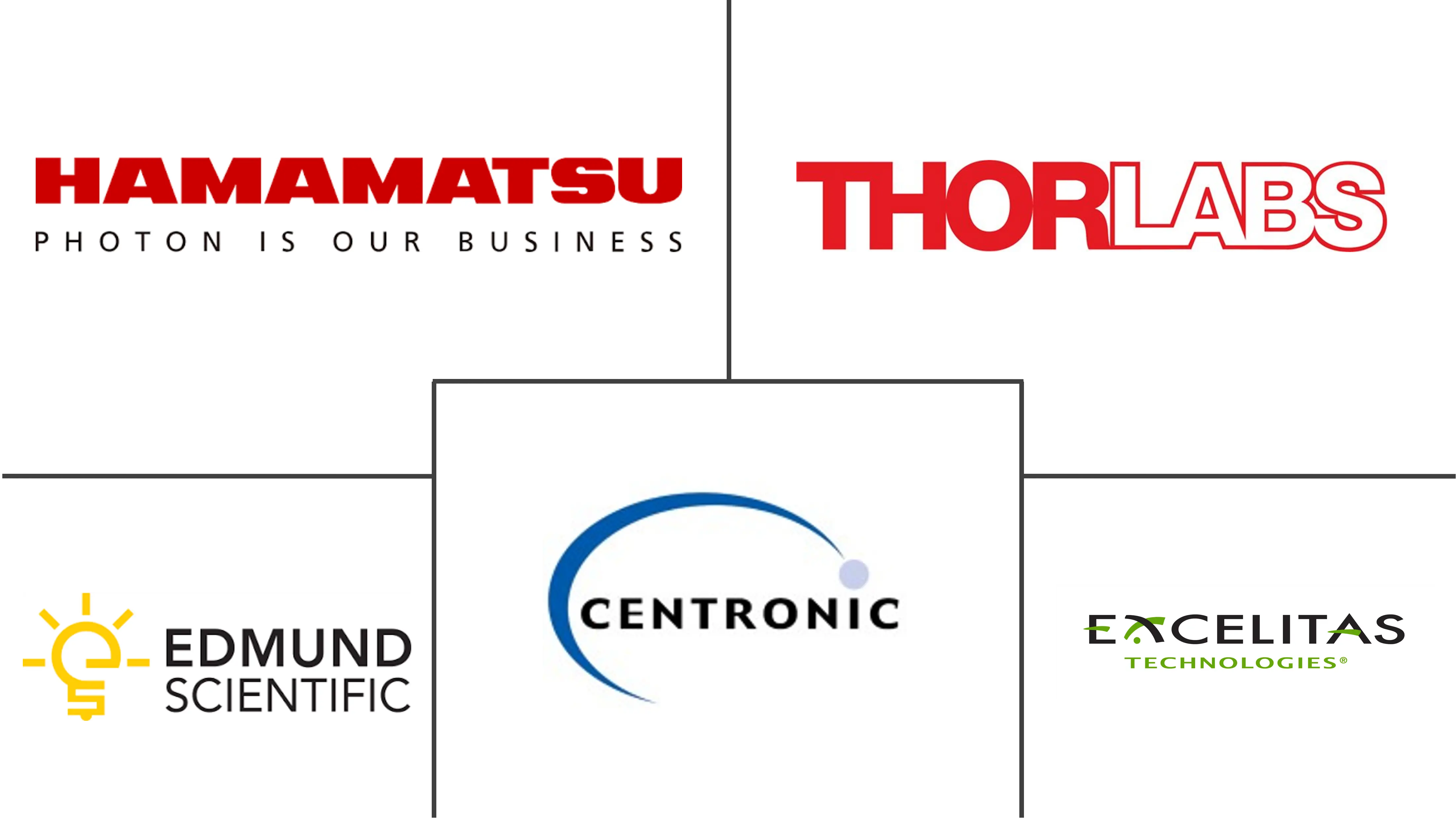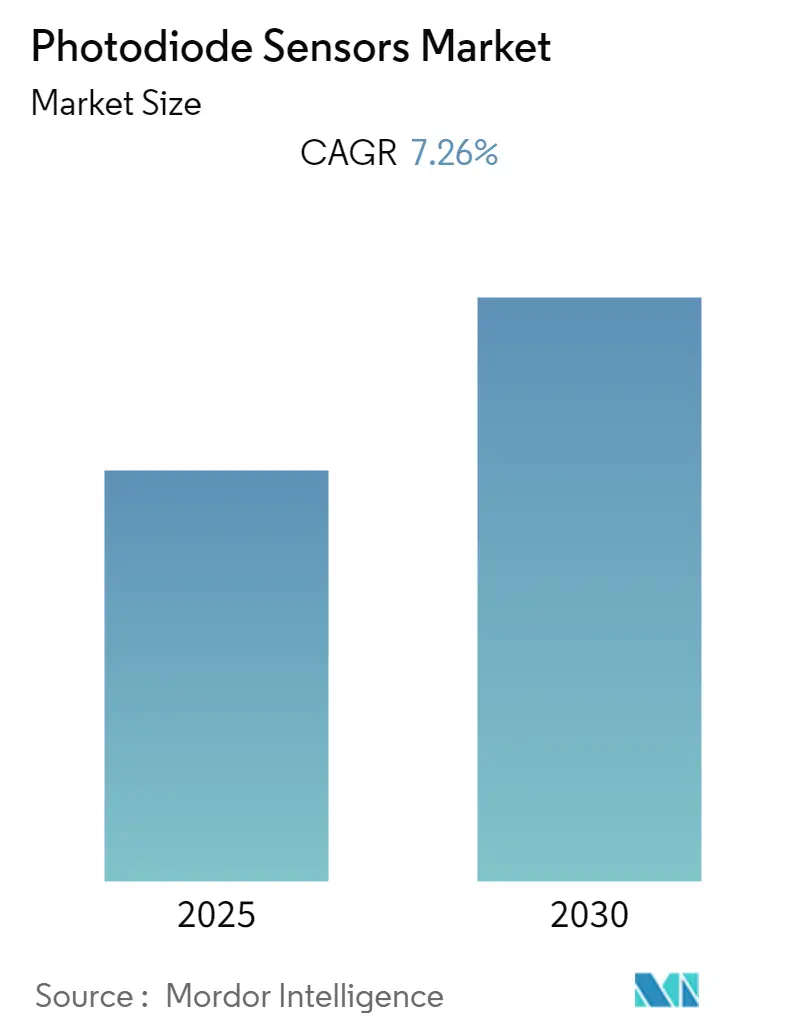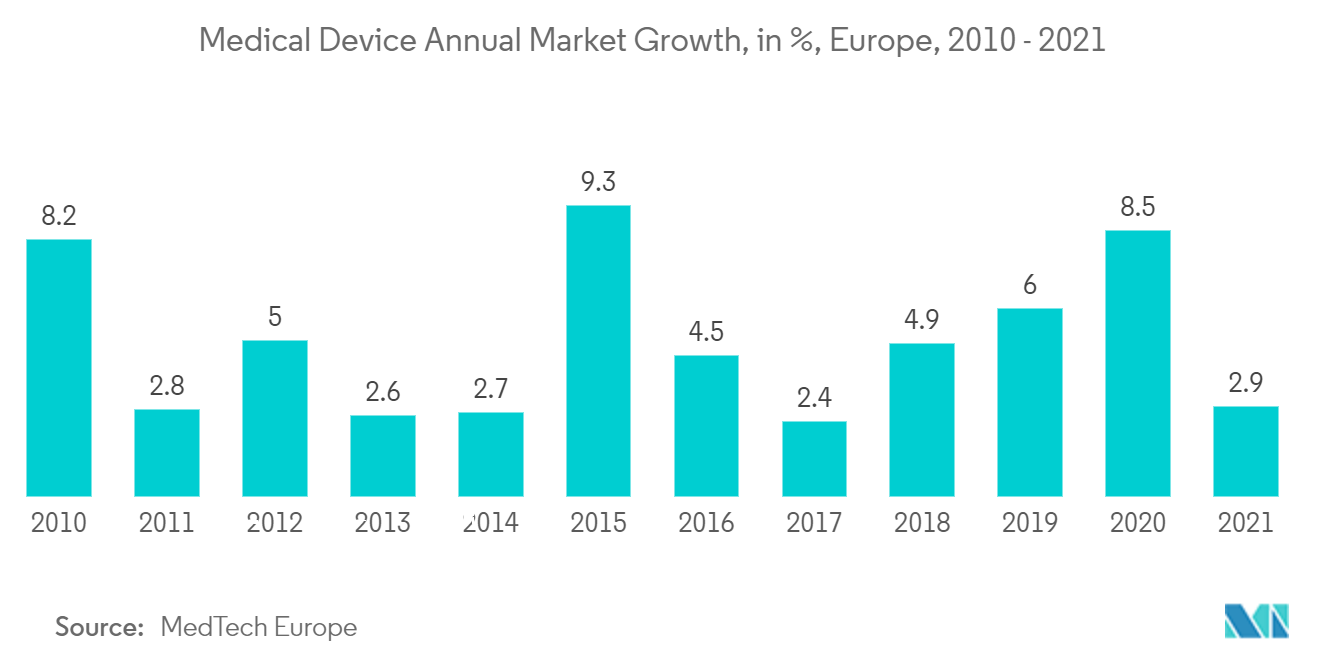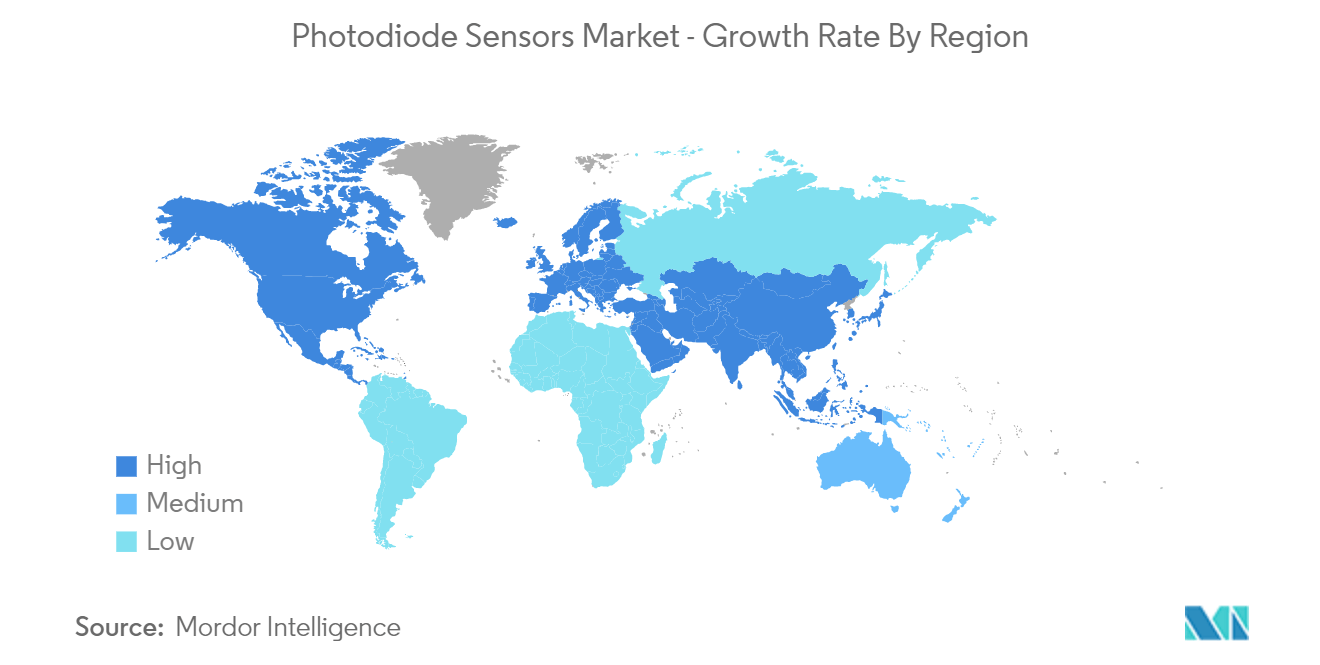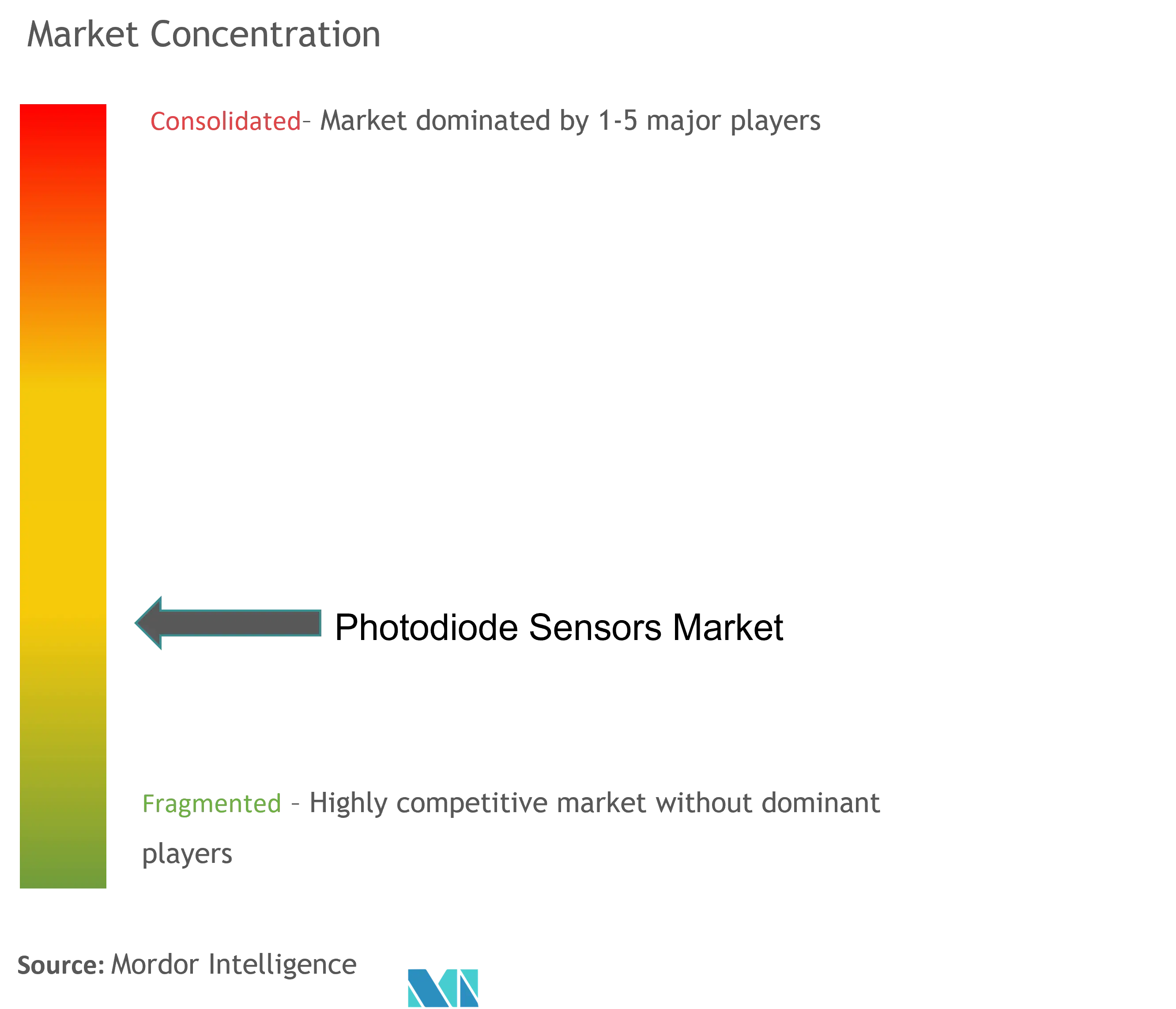Photodiode Sensors Market Analysis
The Photodiode Sensors Market is expected to register a CAGR of 7.26% during the forecast period.
- Photodiode sensors have a few special characteristics that make them stand out, including integrated functionality, improved performance, high reliability, and rapid response times. Therefore, the growing use of light/optical sensors in medical devices, aerospace & defense, and consumer electronics is expected to be a highly lucrative segment during the forecast period, contributing to the growth of the global photodiode sensor market.
- Moreover, the market for photodiodes will also be boosted by Wearable Health Devices, which include fitness trackers and smartwatches and are used for various applications including blood oxygen concentration, optical heart rate detection and health monitoring. Photodiodes are also used in devices for monitoring blood pressure, body temperature, etc. which will likely fuel further market expansion.
- Barcode scanning is another use for photodiodes, which helps organizations track a lot of data and is employed to boost productivity and efficiency in a variety of industries. Another important factor driving the expansion of the photodiode sensor market is the growing awareness of the quick processing times for billing and purchase transactions as well as improvements in the impact of the customer experience in retail stores. These developments are also driving an increase in the demand for barcode scanners across the retail sector.
- Additionally, The development of new optical detectors will increase the demand for photodiodes, as will the use of photodiodes by smartphone cameras and proximity sensors to identify objects or focus on them. These developments in semiconductor technology and the emergence of new applications (optical communication, optical sensing, etc.) drive this demand. These factors will encourage market growth.
- However, one of the main obstacles to the growth of the global photodiode sensor market is the temperature dependence of photodiodes. Every photodiode has a temperature dependence that affects its dark current, shunt resistance, sensitivity, and breakdown voltage when the temperature changes. This also affects other factors, such as junction capacitance, which negatively affects a photodiode's general performance characteristics.
- The demand for photodiode sensor has been rising quickly as the global economies recover from the COVID-19 pandemic. This quick increase in demand has been witnessed especially in the personal medical devices segments as the pandemic has significantly enhanced the health conciousness of the people. Hence, the increased use of sensors spurs new developments and aids the vendors further expand their market presence.
Photodiode Sensors Market Trends
Avalanche Photodiodes Sensors Segment will Hold the Prominent Share in the Market
- Optics has impacted people's lives by altering medical practice and presenting fresh solutions to significant health issues. A less invasive approach to treating disease with minimally invasive therapies has been made possible by the growing use of optics and fiber optics. Optics has made it possible for laser surgery, optical diagnostic methods, and visualization of the body's interior. Avalanche photodiodes built into the optical machines used for medical applications have been gaining traction owing to several benefits they offer.
- Avalanche photodiodes (APDs) are photodetectors that use the photoelectric effect to transform light into electricity. They have an integral gain mechanism. Numerous industries use avalanche photodiodes, which are made of materials like silicon, InGaAs, and germanium. The use of the device in the medical field is responsible for the avalanche photodiodes market expansion. For instance, according to MedTech Europe, the annual growth rate recorded for medical devices in Europe was 8.5% in 2020 and 2.9% in 2021.
- Medical equipment, especially diagnostic equipment, has recently seen increased demand in the healthcare industry. Medical equipment that measures blood oxygen levels uses photodiodes. Solid-state detectors built on silicon called avalanche photodiodes (APDs) transform photons into charge currents. For light and x-ray detections, they offer a small, reliable, magnetic field-insensitive solution with gains in the range of 100 and quick response times. APDs are, therefore, widely utilized in the healthcare industry. APDs have many advantages, including quick response times, superior performance, and longer life.
- As, avalanche photodiodes (APDs) are highly sensitive photodetectors with fast rise time and internal gain mechanism and can be operated at high reverse voltage, optic networks built on avalanche photodiodes are increasingly being used in self-driving cars, especially in LiDAR units. This type of photodiodes are expected to be in high demand due to the use of optical distance for speed measurement in self-driving or automated driving vehices, along with their ability to enables environment monitoring, navigation, and potential road risks in addition to traffic sign recognition.
- Furthermore, avalanche photodiodes which are made of silicon are more affordable than other types and have a wavelength range of 450 to 1000 nm, with the maximum sensitivity occurring between 600 and 800 nm. Additionally, silicon-based APDs provide high sensitivity from UV to NIR for low light detection at high speeds, supporting segment growth.
Asia Pacific to Witness the Significant Growth
- The Asia Pacific region is expected to have the largest and fastest-growing photodiode sensors market because of the region's expanding consumer electronics, automotive, and telecommunications industries. Countries like China, Taiwan, South Korea, Japan, and India dominate the consumer electronics market share. This rise in consumer electronics will lead to a rise in the demand for photodiode sensors in the region.
- The International Trade Center observed that China's consumer electronics exports held the largest market share in the world in 2020, including electrical machinery and equipment worth USD 710.1 billion, computers worth USD 440.3 billion, and lighting and lighting and other electronic goods worth USD 110.0 billion. China has also bolstered its position in 2021 and 2022. Therefore it is expected that China will have a prominent role to play in the future growth of the photodiodes market.
- Additionally, Mining, food processing, automotive, aerospace, electronics & semiconductors, and textile are major industries in the Asia Pacific region that support the economies of the region's countries. These industries make use of laser devices and optical scanners for inspection, scanning, mapping, and planning which will boost the deamd for photodiode sensors in the region, supporting the studied market's expansion during the forecast period.
- Furthermore, the growth of the automotive industry is also expected to support the studied market's growth in the Asia Pacific region as automotive manufacturers are continuously focusing on manufacturing automobiles that can match the international standards. This in turn is driving innovations in the photodiode industry as vendors are continuously launching new products to cater to the growing demand.
- For Instance, in June 2021, Samsung Electronics, South Korea, introduced ISOCELL Auto 4AC, an automotive image sensor with advanced 120-decibel (dB) high dynamic range (HDR) and LED flicker mitigation. It includes CornerPixel technology, which includes a specialized pixel structure that reduces LED light above 90 hertz. It embeds two photodiodes within a single pixel area, one 3.0m pixel for viewing low light images and a 1.0m pixel at the corner of the big pixel.
Photodiode Sensors Industry Overview
The Photodiode Sensors Market is fragmented, owing to the presence of several global players and the expansion of these players globally. The presence of many players, as well as their continuous innovative activities, is energizing the market scenario. Hamamatsu Photonics K.K., Thorlabs, Inc., TT electronics, First Sensor AG, Illinois Tool Works Inc., Edmund Optics Inc., Excelitas Technologies Corporation, and others are among the major players covered in the photodiode sensors market.
- November 2022 - Vishay Intertechnology Inc. demonstrated its portfolio of reliable and energy-efficient electronic components, known as the DNA of technology, at Electronica 2022. It displayed its photodiodes and hybrid energy storage capacitors. Also, it demonstrated its new photodiodes, which can power a Bluetooth low-energy transmitter to transmit data to an Android device.
- November 2022 - Advanced Photonix, a unit of OSI Optoelectronics, creates and manufactures silicon (Si) and indium gallium arsenide (InGaAs) surface-mount technology (SMT) photodetectors for high-speed response applications. Additionally, these photodiodes are designed specifically for solder reflow mounts and automated SMT/SMD assembly on ceramic substrates and printed circuit boards.
Photodiode Sensors Market Leaders
-
Hamamatsu Photonics K.K
-
Thorlabs, Inc.
-
Edmund Scientific Corporation (Edmund Optics)
-
Centronic, Ltd.
-
Excelitas Technologies Corporation
- *Disclaimer: Major Players sorted in no particular order
Photodiode Sensors Market News
- July 2022 - OSI Optoelectronics has released a new line of Two-Color Sandwich Photodiodes, also known as dual-sandwich detectors. The devices are designed specifically for optical remote temperature measurements. OSI's dual-sandwich detector family includes an uncooled silicon-silicon detector, an uncooled silicon-InGaAs detector, and a recently introduced silicon-InGaAs photodiode with a two-stage thermoelectric cooler.
- April 2022 - Toshiba Teli has introduced an industrial HD SWIR camera with a CMOS-based SWIR sensor from TriEye. The camera joins others like the Acuros camera from SWIR Vision Systems, which uses colloidal quantum dot thin film photodiode sensors monolithically built on silicon readout wafers.
- February 2022 - Kyoto Semiconductor Co., Ltd., a leading manufacturer of optical device solutions, partnered with Rochester Electronics LLC to offer customers active and end-of-life (EOL) products. The collaboration broadens Kyoto Semiconductor's global customer base while expanding Rochester Electronics' product offering with Kyoto Semiconductor's optical communication products such as photodiodes.
Photodiode Sensors Industry Segmentation
Photodiode sensors are light-sensing devices that convert light energy into electrical energy. Photodiodes produce an electric current by using light energy as an input. Photodiodes are semi-conducting components with PN junctions, also referred to as light detectors, photosensors, or photodetectors.
The study tracks the sales of Photodiode Sensors in the Global Market. Both Monolithic and assembled modules that detect the presence of light and change it into electrical voltages or currents - discrete and combo sensors such as Ambient Light Sensors (ALS), Proximity Sensors, Color Sensors, etc. are tracked as a part of the study. The photodiode sensors market is segmented into sensor types (PN Photodiode Sensors, PIN Photodiode Sensors, Avalanche Photodiode Sensors, Schottky Photodiode Sensors), By End-User Industry (Consumer Electronics, Telecommunications, Aerospace & Defense, Healthcare, Automotive, and Industrial), and By Geography. Additionally, the impact analysis of COVID-19 is also part of the study. The market sizes and forecasts are provided in terms of value (USD million) for all the above segments.
| By Sensor Type | PN Photodiode Sensors |
| PIN Photodiode Sensors | |
| Avalanche Photodiode Sensors | |
| Schottky Photodiode Sensors | |
| By End User Industry | Consumer Electronics |
| Telecommunications | |
| Aerospace and Defense | |
| Healthcare | |
| Automotive | |
| Industrial | |
| Other End-user Industries | |
| By Geography | Americas |
| Europe | |
| China | |
| Japan | |
| Rest of the World |
Photodiode Sensors Market Research FAQs
What is the current Photodiode Sensors Market size?
The Photodiode Sensors Market is projected to register a CAGR of 7.26% during the forecast period (2025-2030)
Who are the key players in Photodiode Sensors Market?
Hamamatsu Photonics K.K, Thorlabs, Inc., Edmund Scientific Corporation (Edmund Optics), Centronic, Ltd. and Excelitas Technologies Corporation are the major companies operating in the Photodiode Sensors Market.
Which is the fastest growing region in Photodiode Sensors Market?
Asia-Pacific is estimated to grow at the highest CAGR over the forecast period (2025-2030).
Which region has the biggest share in Photodiode Sensors Market?
In 2025, the North America accounts for the largest market share in Photodiode Sensors Market.
What years does this Photodiode Sensors Market cover?
The report covers the Photodiode Sensors Market historical market size for years: 2019, 2020, 2021, 2022, 2023 and 2024. The report also forecasts the Photodiode Sensors Market size for years: 2025, 2026, 2027, 2028, 2029 and 2030.
Our Best Selling Reports
Photodiode Sensors Industry Report
Statistics for the 2025 Photodiode Sensors market share, size and revenue growth rate, created by Mordor Intelligence™ Industry Reports. Photodiode Sensors analysis includes a market forecast outlook for 2025 to 2030 and historical overview. Get a sample of this industry analysis as a free report PDF download.

